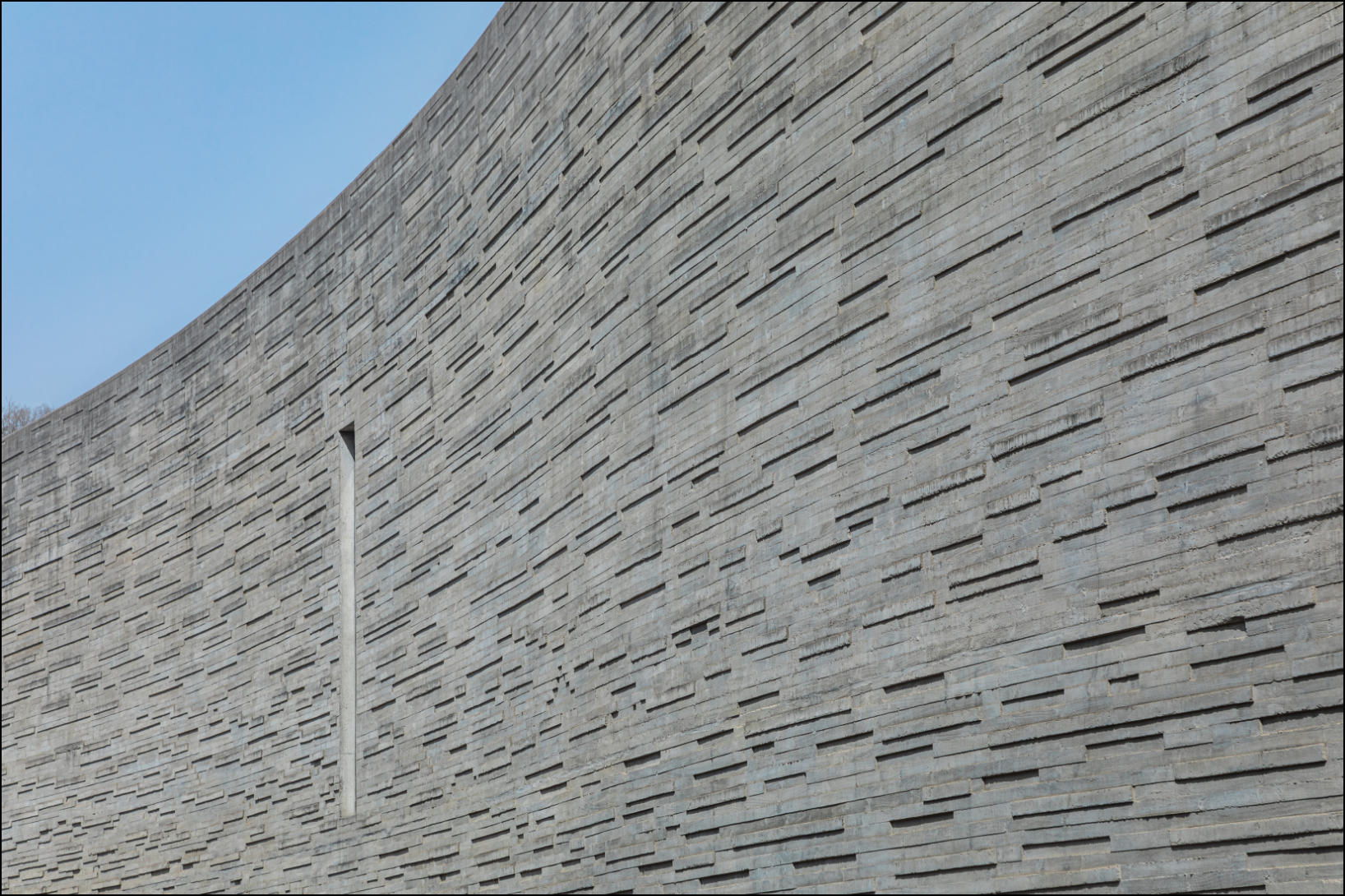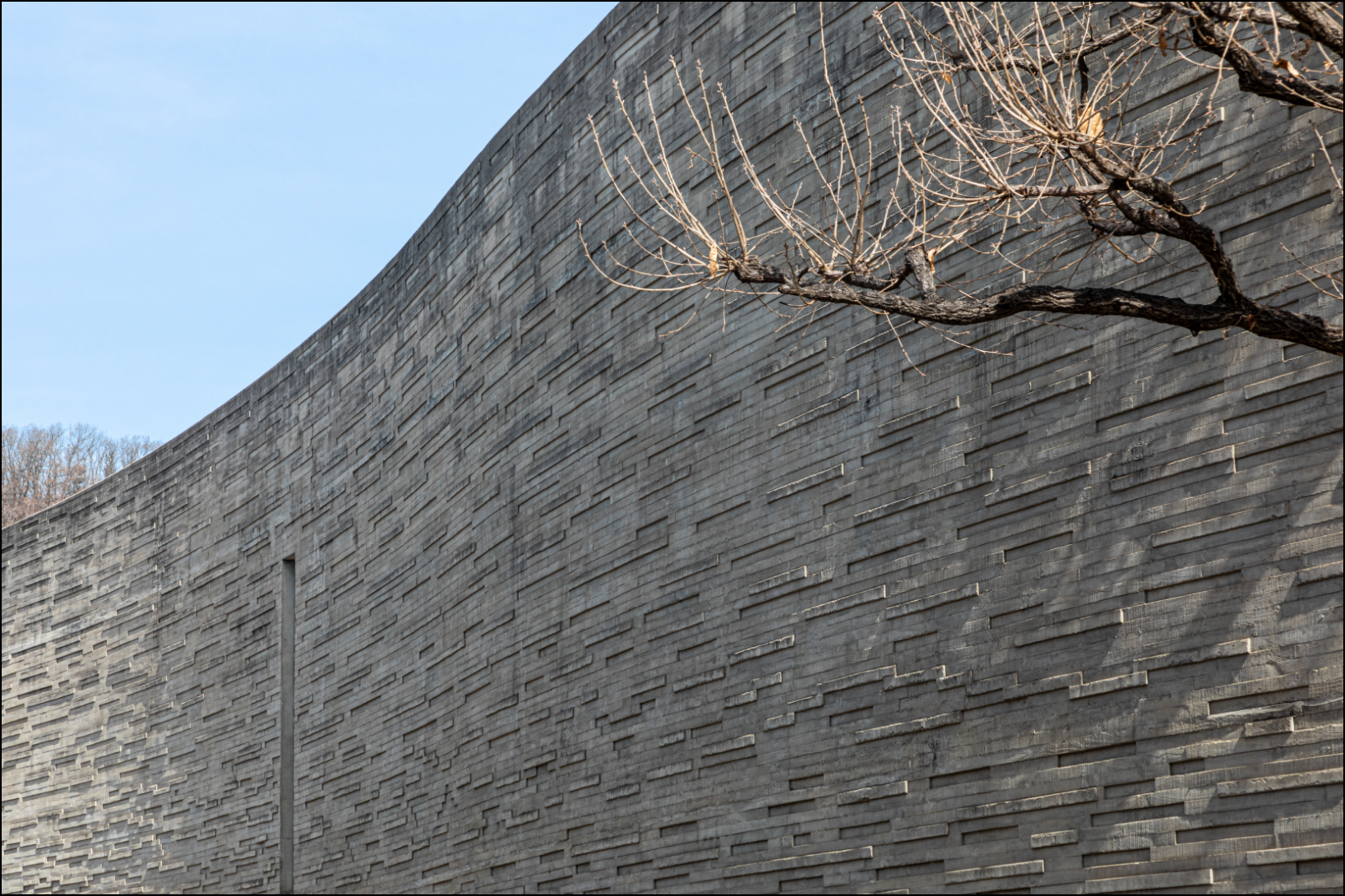
건축
Architecture
|




|
습지를 끼고 있는 평지의 지형이 대부분이었던 파주 헤이리 예술마을안에서 미술관 설립자 백순실 작가는 작은 산자락의 삼각형 모양 대지를 부지로 선정하였습니다. 자연과 연결된 건축적 방향을 염두에 두었던 설립자의 의지는 도토리 열매를 맺는 굴참나무 군락지였던 산 아래 길가의 오래된 나무 한 그루와 거대한 콘크리트 덩어리가 대화하듯 공존하는 공간을 만들게 되었습니다. 미술관의 이름 또한 건축적 상징인 이 굴참나무 학명의 마지막 단어인 블루메(Blume)에서 비롯되었습니다. 기존의 아름드리 굴참나무를 베지 않고 감싸 안듯 지어진 미술관 건축은 2005년 건축가 우경국이 디자인하였습니다. 그는 경북 양동마을의 조선시대 전통가옥 ‘향단’의 건물 및 공간배치 형식을 재해석하여 산비탈 경사지에 U자 형 배치로 중앙에 마당을 두고 좌우측 각각에 두 공간, 그리고 전면 가로변에는 전시실을 배치하였고 양끝에서 건물의 중심공간으로 들어가도록 되어 있습니다. 건축설계에 있어 동선을 짧게 하는 것이라 아니라 길게 하는 것에 초점을 맞춘 그의 디자인은 ‘긴 동선’을 통해 더 많은 시각적 변화를 인지하게 되고 다양한 공간감을 통해 건축물이 가지고 있는 스토리를 경험하게 합니다. 노출 콘크리트의 요철과 나무가 벽에 드리우는 그림자로 하루 종일 인상이 변하는 건물의 파사드는 미술관 설립자인 백순실 작가의 캔버스 작업 중 거친 질감으로 갈색 대지의 생명력을 담아낸 ‘동다송(東茶頌)’을 건축적으로 해석한 것으로 콘크리트 요철의 텍스처와 땅의 인상을 동일시한 것입니다. 블루메미술관은 자연과 사람의 조화를 주제로 한 친환경적 건축으로 2006년 대한민국 건축상을 수상하였습니다. 건축학도를 비롯한 많은 이들이 다양한 재료와 건축의 언어를 경험하기 위한 공부의 장소로 헤이리 예술마을을 찾았던 시기 주요 건축물 중의 하나로 2005년부터 2012년까지 금산 갤러리가 공간을 활용하였습니다. 1992년 사간동에 개관한 금산갤러리는 국내외 현대미술작가들을 소개해온 중요 화랑으로 헤이리 예술마을로 이전하며 중국현대미술페스티벌, 일본현대미술페스티벌 등 아시아 현대미술을 마을 곳곳의 공간과 협력하여 소개하는 대규모 프로젝트로 예술마을로서 헤이리의 위상을 다지는데 중요한 역할을 하였습니다. 본래 비영리 목적의 미술관을 만들고자 했던 설립자 백순실 작가의 의지를 기반으로 본 건축물은 2013년 국가 등록 절차를 거쳐 사립미술관으로써 현재까지 운영되어 왔고 자연과 공존하고자 한 건축적 철학이 지속적인 동력이 되어 ‘자연과 연결되는 미술관’ 이라는 지금의 새로운 비전을 품게 되었습니다. “가장 중요하게 생각한 것은 자연과 건축의 관계를 새롭게 설정하고자 한 것이다. 즉, 땅, 바람, 수목, 물, 빛, 하늘과 건축이 어떻게 만나야 하는가의 문제이다. 모든 사물의 존재는 스스로 존재할 수 없는 것과 같이, 모든 현상은 독립된 존재로 현상하는 것이 아니라 상호관계되어지면서 또 다른 현상을 만들어내는 관계되어진 현상인 것이다. 이 미술관에서는 바로 이러한 관계현상의 미학을 기본개념으로 하고 있다. 산책을 하듯 길을 따라 움직이면서 전개되는 공간과 풍경은 시점에 따라 중첩되거나, 사라지기도 하면서 막힘, 트임, 중첩, 빛, 바람을 느끼고 인식시켜 주는 이야기성 공간이 끊임없이 현상한다. 마치 영화를 보거나 시를 읽는 것과 같은 공간의 이야기는 하나의 사건에 고착하지 않고 끊임없이 새로운 가능성을 암시하게 됨으로써 서로 얽히고 교차하게 된다. 수목의 가지가 벽을 뚫고 나온 전면의 휘어진 콘크리트벽은 시간에 따라 매우 다른 표정을 지니게 된다. 이 벽은 ‘동다송’이라는 백순실의 90년대 작업을 이 땅의 야생적 흔적과 관련하여 콘크리트라는 물질의 필획을 통하여 공중에 그어 넣음으로써 땅과 수목이 지니고 있었던 시간성과 백순실 작가 작업과의 소통을 존재로 한 것이다. 그 자리에 존재하는 나무는 건축이며 동시에 관습적 공간의 내 외부개념을 해체하는데 커다란 도움이 되었다. 거친 콘크리트벽이 그림처럼 인식되었다는 것은 물질이 자기 스스로의 모습으로, 자기의 진상 그대로써 존재하게 됨을 의미한다.” - 건축가 우경국
|
The founder BAIK Soon Shil selected a triangular-shaped piece of land at the foot of a hill in Heyri Art Village as the site for the museum. Keeping in mind the architectural purpose of integrating the building with nature, the founder’s determination resulted in a space in which an old Chinese cork oak coexists with a gigantic concrete mass. The museum’s name has been derived from the last word of the tree’s scientific name ‘Blume’. The museum building designed by architect WOO Kyung Kook in 2005 was built to preserve a preexisting large Chinese cork oak, not cutting down or uprooting the tree. He arranged the museum spaces in a U-shape on a hilly slope, reinterpreting the layout of Hyangdan, a Korean traditional house in Yangdong Village, Gyeongsangbuk-do during the Joseon period. The yard is set in the middle, there are two spaces on both sides, and there is a gallery on the roadside in the front of the building. Visitors can enter its central space from both sides. Focusing primarily on making the line of movement through the space long, not short, this design allows visitors to perceive more visual changes and better experience the stories the building retains. The facade of the building, whose impression varies depending on the shadows the tree casts on the walls throughout the day, is an architectural reinterpretation of Baik’s Dongdasong series that captures the life force of the brown earth in rough textures. This regards the texture of the exposed concrete in the same light as the impression of earth. This eco-friendly building based on the theme of harmony between nature and man was awarded the Korean Architecture Award in 2006. It was one of the main buildings in Heyri in the period when many, including students of architecture, visited Heyri Village as a place to study and experience a wide variety of building materials and architectural idioms. The museum was used as Keumsan Gallery from 2005 to 2012. The gallery launched in 1992 in Sagan-dong, Seoul was an important art space that introduced domestic and foreign contemporary artists. After moving to Heyri, the gallery played a leading role in cementing Heyri’s status as an art village through its large-scale projects and exhibitions featuring contemporary Asian art such as the Contemporary Chinese Art Festival and the Contemporary Japanese Art Festival in collaboration with other spaces in Heyri. Registered as a private museum in 2013, the BMCA has been carrying its operations in this building constructed based on founder BAIK Soon Shil’s vision. Constantly motivated by the architectural philosophy of coexisting with nature, it comes to have its current function as an art museum connected to nature. “What matters most is to establish a new relationship between nature and architecture. That is to say, this is the matter of how architecture has to integrate with the earth, wind, trees, water, light, and the sky. Just as nothing can be self-existent, every phenomenon is interrelated with other phenomenon. The fundamental concept the museum is based on is the aesthetics of such a relational phenomenon. Its spaces and landscapes overlap or vanish from sight in accordance with different viewpoints while narrative spaces that make one feel or perceive light and wind continuously appear. These spatial narratives that seem like seeing a movie or reading a poem become entangled or mingled by endlessly suggesting a new possibility without being confined to any one single event. The curved wall through which tree branches emerge can have a very different appearance depending on the time. This wall presupposes the temporality the earth and the tree retain and communication with Baik’s 1990s’ work Dongdasong through the material of concrete. The tree in that place is a part of the museum and is one of the great contributions to deconstructing the internal and external concept of a conventional space. The rough concrete wall perceived as a picture means that material exists in its own appearance or true nature as it is.” - Architect WOO Kyung Kook


